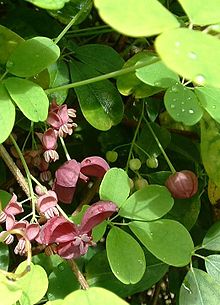Akebia quinata
| Akebia quinata | |
|---|---|

| |
| Scientific classification | |
| Kingdom: | Plantae |
| Clade: | Tracheophytes |
| Clade: | Angiosperms |
| Clade: | Eudicots |
| Order: | Ranunculales |
| Family: | Lardizabalaceae |
| Genus: | Akebia |
| Species: | A. quinata
|
| Binomial name | |
| Akebia quinata | |
| Synonyms | |
|
Rajania quinata Houtt. | |
Akebia quinata, commonly known as chocolate vine, five-leaf chocolate vine,[1] or five-leaf akebia, is a shrub that is native to Japan, China and Korea, and naturalized in the eastern United States from Georgia to Michigan to Massachusetts.[2][3][4]
Appearance
Akebia quinata grows to 10 m (30 ft) or more in height and has compound leaves with five leaflets. The flowers are clustered in racemes and are chocolate-scented, with three or four sepals. The fruits are sausage-shaped pods which contain edible pulp.[2][5] The gelatinous placentation contains seeds that have a sweet flavor.[citation needed]
Synonyms
In China, A. quinata is referred to as 木通 – mù tōng (Pinyin) or mu tung (Wade-Giles) – meaning "woody thoroughgoing (plant)". It is also occasionally known as 通草 – tōng cǎo (Pinyin) or tung tsao (Wade-Giles) – meaning "thoroughgoing grass".
Uses
The rind, with a slight bitter taste, is used as vegetable, e.g., stuffed with ground meat and deep-fried. The vines are traditionally used for basket-weaving.[6]
The stem contains approximately 30% potassium salts thus causing a diuretic action.[7][unreliable medical source?]
Regulation
Akebia quinata is listed in the National Pest Plant Accord list which identifies pest plants that are prohibited from sale, commercial propagation, and distribution across New Zealand.
Etymology
‘Akebia’ comes from the Japanese vernacular name, ‘akebi’ (アケビ).[8]
‘Quinata’ means ‘divided into five’, and is presumably a reference to its lobed leaves.[8]
Gallery
-
Female flower and 5 male flowers in Mount Ibuki
-
Fruit
-
Sketch
See also
References
- ^ English Names for Korean Native Plants (PDF). Pocheon: Korea National Arboretum. 2015. p. 345. ISBN 978-89-97450-98-5. Archived from the original (PDF) on 25 May 2017. Retrieved 25 January 2016 – via Korea Forest Service.
{{cite book}}: Unknown parameter|deadurl=ignored (|url-status=suggested) (help) - ^ a b Levy-Yamamori, Ran; Ran Levy; Gerard Taaffe (2004). Garden Plants of Japan. Timber Press. ISBN 0-88192-650-7. Retrieved 2009-04-05.
- ^ "Akebia quinata". Flora of China. Retrieved 2009-04-05.
- ^ Flora of North America vol 3
- ^ Decaisne, Joseph. Archives du Muséum d'Histoire Naturelle 1: 195, pl. 13a. 1839.
- ^ taken from ja:アケビ (2011.11.3(Thu) 12:08)
- ^ Reid, Daniel (2001), "A Handbook of Chinese Healing Herbs", Tuttle Publishing, ISBN 962-593-988-1. Retrieved on 2009-05-20.
- ^ a b Gledhill, David (2008). "The Names of Plants". Cambridge University Press. ISBN 9780521866453 (hardback), ISBN 9780521685535 (paperback). pp 40, 324
External links
- Akebia quinata (Houtt.) Dcne. (ITIS)
- Akebia quinata (Houtt.) Decne. Medicinal Plant Images Database (School of Chinese Medicine, Hong Kong Baptist University) Template:Zh-hant Template:En icon



